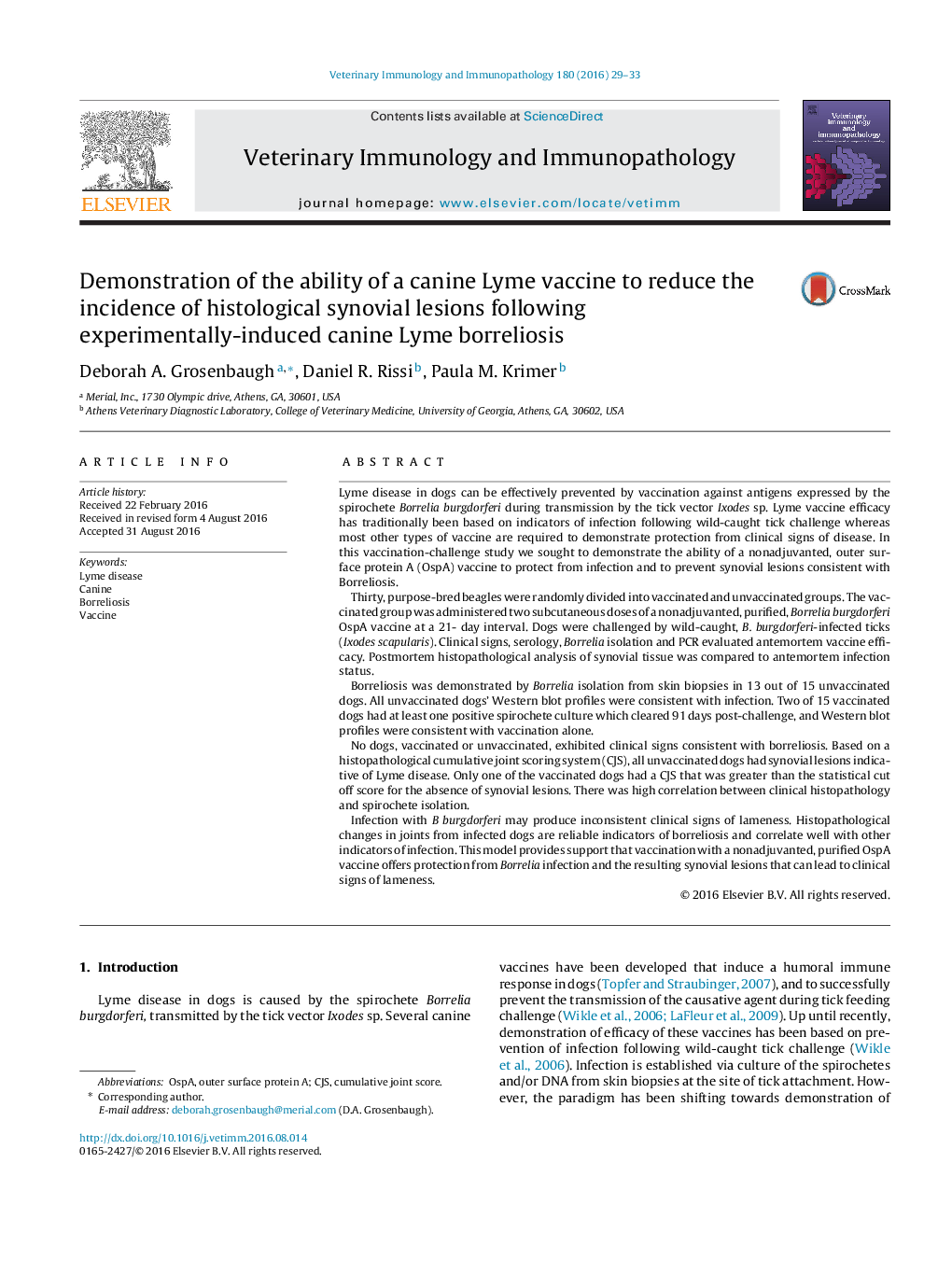| کد مقاله | کد نشریه | سال انتشار | مقاله انگلیسی | نسخه تمام متن |
|---|---|---|---|---|
| 2461284 | 1555004 | 2016 | 5 صفحه PDF | دانلود رایگان |
• 30 beagles, unvaccinated or vaccinated with a nonadjuvanted, B. burgdorferi OspA vaccine, were exposed to B. burgdorferi-infected ticks.
• Vaccine efficacy was evaluated antemortem through. Borrelia isolation and PCR at the site of tick attachment.
• Postmortem histopathological analysis of synovial tissue was compared to antemortem infection status.
• Histopathological changes in joints from infected dogs are reliable indicators of borreliosis and correlate well with infection status.
• Vaccination with a nonadjuvanted purified OspA vaccine protects from Borrelia infection and the synovial lesions that can result in lameness.
Lyme disease in dogs can be effectively prevented by vaccination against antigens expressed by the spirochete Borrelia burgdorferi during transmission by the tick vector Ixodes sp. Lyme vaccine efficacy has traditionally been based on indicators of infection following wild-caught tick challenge whereas most other types of vaccine are required to demonstrate protection from clinical signs of disease. In this vaccination-challenge study we sought to demonstrate the ability of a nonadjuvanted, outer surface protein A (OspA) vaccine to protect from infection and to prevent synovial lesions consistent with Borreliosis.Thirty, purpose-bred beagles were randomly divided into vaccinated and unvaccinated groups. The vaccinated group was administered two subcutaneous doses of a nonadjuvanted, purified, Borrelia burgdorferi OspA vaccine at a 21- day interval. Dogs were challenged by wild-caught, B. burgdorferi-infected ticks (Ixodes scapularis). Clinical signs, serology, Borrelia isolation and PCR evaluated antemortem vaccine efficacy. Postmortem histopathological analysis of synovial tissue was compared to antemortem infection status.Borreliosis was demonstrated by Borrelia isolation from skin biopsies in 13 out of 15 unvaccinated dogs. All unvaccinated dogs’ Western blot profiles were consistent with infection. Two of 15 vaccinated dogs had at least one positive spirochete culture which cleared 91 days post-challenge, and Western blot profiles were consistent with vaccination alone.No dogs, vaccinated or unvaccinated, exhibited clinical signs consistent with borreliosis. Based on a histopathological cumulative joint scoring system (CJS), all unvaccinated dogs had synovial lesions indicative of Lyme disease. Only one of the vaccinated dogs had a CJS that was greater than the statistical cut off score for the absence of synovial lesions. There was high correlation between clinical histopathology and spirochete isolation.Infection with B burgdorferi may produce inconsistent clinical signs of lameness. Histopathological changes in joints from infected dogs are reliable indicators of borreliosis and correlate well with other indicators of infection. This model provides support that vaccination with a nonadjuvanted, purified OspA vaccine offers protection from Borrelia infection and the resulting synovial lesions that can lead to clinical signs of lameness.
Journal: Veterinary Immunology and Immunopathology - Volume 180, 1 November 2016, Pages 29–33
